Growing conditions
The flowering of violets depends on the conditions created, we will consider them in more detail.
Priming
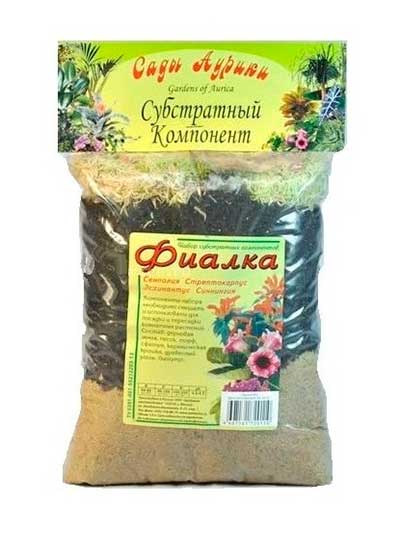
First of all, you need to purchase a special soil for growing Saintpaulias.
It is a light and friable nutritional mixture that contains the elements you need for your flowers.
Some growers advise adding ordinary garden soil to the soil, which is disinfected in the oven by calcining.
This is done so that the earth retains moisture better.
It is imperative that drainage is laid out on the bottom of the pot, otherwise excess moisture will linger.
Which pot should you plant?
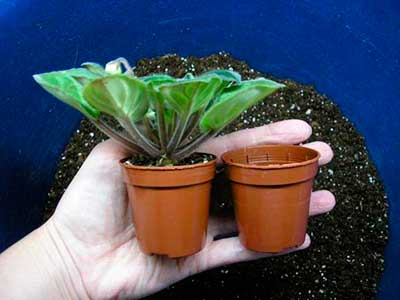
The choice of a pot for planting violets is also an important point in breeding it.
It is believed that violets do not like large pots. The root system of these flowers takes too long to grow, and the plant does not have the energy and time for its main purpose - flowering.
A pot that is too small will not suit a violet either. Therefore, choosing the size is not easy, but there are recommendations from experienced gardeners - florists: the pot should be about 10 cm high and 10 to 13 cm in diameter.
Lighting features
Features of violets lighting: a lot of light, but at the same time exclude direct sunlight.
Attention! Violets are not friendly with the sun's rays! Moreover, the sun can cause burns and diseases on the leaves of the flower. You need to choose such a place for your pets, what would you choose for your child on the beach: light, warm, a lot of sun, but no direct rays .. It is best to arrange pots with Saintpaulias on the windowsills of the northern side of your home
If this is not possible, and your windows are located only on the south side, you can hang a thick fabric curtain on the window. It will protect flowers from direct rays, but at the same time let in enough light.
It is best to place your Saintpaulia pots on the windowsills on the north side of your home. If this is not possible, and your windows are located only on the south side, you can hang a thick fabric curtain on the window. It will protect the flowers from direct rays, but at the same time allow enough light to pass through.
Temperature
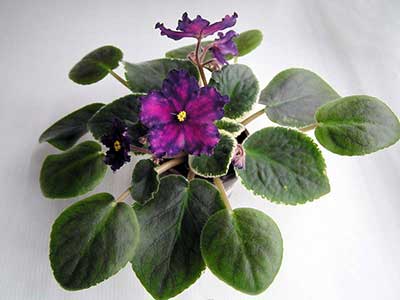
16-20 degrees is the required temperature for reproduction and cultivation of both our “Southern Night” variety and all other violets.
Day and night temperatures should not be the same, and they will differ by 3-4 degrees.
In winter, it is advisable to remove the flower pots from the windowsills to another place in order to avoid hypothermia of the plants.
Air humidity

All varieties of violets are known for their demanding air humidity. However, the plant cannot be sprayed.
To increase the humidity of the air, containers with water can be placed next to the flower pots. Warm showers can be held once a month for violets.
After washing the plant, dip the leaves with a paper towel so that no water drops remain. This procedure is used to improve the decorative qualities.
Find out about other varietal Saintpaulias: violet "Goddess of Beauty", violet "Sea Wolf", violet "Chateau Brion", violet "Dance of Galaxies", violet "Black Pearl", violet "Angelica", violet "LE Isadora", violet "Duchess", violet "Winter smiles" and others.
Growing process
Saintpaulia lovers are often divided into two camps. The first ones believe that it is easy and pleasant to grow it. They argue that it doesn't take long. The latter call this process very troublesome, and the violet itself is very capricious. In fact, in order not to destroy the plant, it is enough to adhere to a few basic rules for growing and caring for an African guest.
Container and soil
You shouldn't pay too much attention to the quality of the container or pot."Dandy" grows well both in a plastic bucket and in a ceramic bowl
The main thing is that the container has holes at the bottom and stands in a shallow saucer. Small shoots are conveniently kept in special violet "manger", which is a small rack with many small pots. For an adult flower, a container with a diameter of 10 cm and the same depth is enough.
As for the soil, its preparation also does not take too long. You can simply take a small amount of soil from any deciduous forest. Anyone who prefers to purchase soil in a store can choose a special composition that includes:
- turf;
- humus;
- sand;
- sphagnum moss.
Lighting
The violet "Dandy", accustomed to the heat, requires a lot of light even in home conditions. It is on the illumination that the growth rate and the duration of the flowering of the violet depend. There is only one way to ensure this under the roof of a house or apartment - to put the flower on the windowsill. However, there are also some nuances here.
- It is better to choose an east or west window so that the light is diffused, otherwise it will easily burn the delicate leaves and petals.
- If all windows of the apartment face south, the glass should be slightly shaded.
- The kitchen is the best room for "Dandy", as it is always warm in it due to the preparation of dishes and the operation of appliances.
- A signal of an overabundance of direct sunlight will be withered and discolored leaves, which will begin to stretch upward, breaking the outlet.
Humidity
The main condition for the growth and development of violets is timely and correct watering. The procedure depends primarily on the season. So, in the summer, the plant should be watered 1-2 times a week, depending on the weather outside the window. In winter, it is best to limit watering by adding water as the potted soil dries.
There are several ways to properly water Saintpaulia.
- Above. In this case, you need to use a watering can or a kettle with a narrow spout and pour water on the ground, under the roots of the plant.
- Below. With this watering, water is poured into the lower saucer-stand in which the pot stands. The plant itself will absorb the amount of water that it needs in 20-30 minutes. After half an hour, the water remaining in the saucer is simply poured into the sink. If you leave it, the roots of the violet will begin to rot, and soon the flower will die.
Excess moisture, which parts of the violet will not have time to absorb during the procedure, is best removed with ordinary paper napkins. The water droplets remaining on the trunk and leaves of Saintpaulia will serve as strong magnifiers for sunlight and leave burns on the velvet skin. The humidity of the room itself should also be considerable, so a container of water can be placed next to the flower pot. As the liquid dries, it needs to be added.
Top dressing
In spring and summer, violet requires the introduction of mineral fertilizers with phosphorus and potassium. They promote the appearance of fresh buds and color the flowers in a brighter pink color. During the growth of young violets, nitrogen fertilization can be applied to the soil, it contributes to the development of the flower. In these cases, it is best to use ready-made liquid preparations, which are sold at any gardening store. Two hours before feeding, you need to water abundantly so that the chemicals do not burn the small roots.
It is always better to underfeed the African Saintpaulia than to overfeed it. If the plant looks healthy on the outside, it is best not to add anything to it at all. In the case of an overabundance of minerals, flowering may not occur or may be very delayed.
Violet South Night: Cultivation
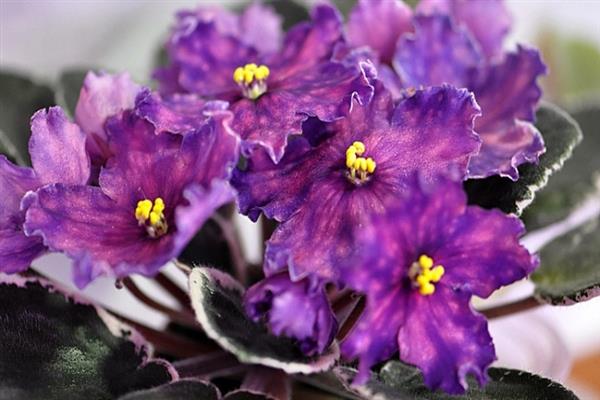
Violet South night: photo
In order for the LE South violet to bloom regularly and magnificently, the plant should be created comfortable conditions, this rule applies to any, even the most unpretentious plant.
When choosing a flower pot for violets, you should give preference to small containers, since a violet growing in a voluminous pot will direct all its forces to building up the root system, and this will happen to the detriment of flowering. For an adult plant, a flower pot with a height of 10 cm and a diameter of 11-13 cm will be the most optimal. There are no clear recommendations regarding the material from which the container is made, since there are so many gardeners, there are so many opinions. Some prefer to grow violets in plastic containers, while others prefer exclusively ceramic flower pots.
If we consider this issue from the point of view of environmental friendliness, then of course a breathable ceramic container is the best option for any indoor plant, perhaps with the exception of orchids, which feel more comfortable in plastic pots.
The second important factor on the road to success will be a soil suitable for violets. Now in large flower shops you can buy specially prepared soil for almost any plant, including Saintpaulias. Before planting, it is recommended to carry out preventive treatment and spill the soil with a solution of potassium permanganate or bake it in the oven to guarantee the destruction of all pathogenic bacteria, and then add fine expanded clay or vermiculite to the soil in order to achieve the best looseness and moisture permeability. As with any houseplants, before planting violets, be sure to lay a layer of drainage material on the bottom of the flower pot, which will prevent stagnation of water in the soil.
A violet needs a lot of light for well-being and flowering, this factor must be taken into account when choosing a place for a plant
But at the same time, it is important to remember that the direct rays of the sun will be destructive and leave burns on delicate leaves, therefore, you can place the violet on the windowsill only if the windows of your apartment face the north, east or west side, or if tall trees grow in front of the window that scatter light. In winter, it is better to remove the violet from the windowsill so that it does not suffer from the cold
Violets of the Southern Night variety do not need a cool dormant period, the optimum room temperature throughout the year is from +18 to +22 degrees.
Violet Southern Night loves humid air, while it, like other violets, is not recommended to be sprayed from a spray bottle. To humidify the air, you can place a container with water next to the plants, gradually evaporating, it will humidify the air. Some florists recommend that in the warm season, once a month, give the violet a short warm shower, after which you should definitely blot the leaves with a soft cloth to remove the remaining moisture. It is believed that this procedure improves the decorative qualities of the plant. But since this contradicts the recommendations for spraying, each grower determines the need for this procedure for himself.
Features of flowering, growth and reproduction
Magic Night grows well on a shelf, but still prefers a window.
How long does it take to grow an adult plant?
Under favorable conditions, 10-12 months will pass between the rooting of the baby and the first buds. When growing this variety from a cuttings, you will need to wait 2-3 weeks longer.
Reproduction methods and features
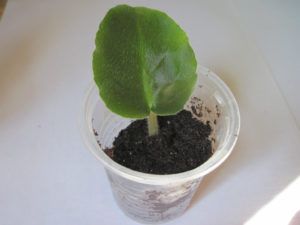 The characteristics of the variety during vegetative propagation are transmitted very well.
The characteristics of the variety during vegetative propagation are transmitted very well.
The order of reproduction of a violet with a leaf cuttings is known to everyone from a school biology textbook:
For rooting, you need a small glass (80 ml) with drainage;
Cut off or carefully break off a healthy leaf from the second tier;
We root the cutting into the ground with the addition of rippers (perlite, vermiculite);
Cover with a greenhouse with another glass or put in a bag;
We are waiting for the baby to appear in a couple of weeks.
A leafy cutting can be rooted in boiled water and then transplanted into soil.
What do peduncles look like?
Peduncles are strong enough, dark-colored. When blooming, they do not fall, they steadfastly bear the weight of the flowers.

The flower stalks of violets are very strong.
Is it possible to achieve nodding flowering?
The variety Magic night has a nodding flowering. The cap is formed by voluminous double flowers and due to the large number of peduncles.
Growing methods
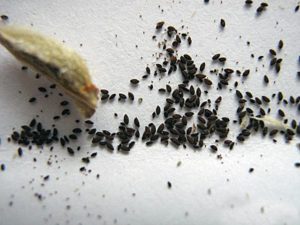 You can grow a new bush using standard breeding methods:
You can grow a new bush using standard breeding methods:
-
Seeds - after dusting, you can get a seed box, and try to raise children. This method is laborious and does not guarantee the effect, the seeds quickly lose similarity, which is rather poor even with freshly harvested material. To obtain offspring, you must:
- Prepare a container: a flat dish is ideal, which can be tightly covered with foil or glass;
- Pour soil, layer thickness 2-3 cm, moisten with a sprayer;
- Sow seeds, you can sprinkle with a very thin layer of substrate, but this is not necessary, cover with glass or film, creating a greenhouse;
- After the emergence of seedlings, you can open the container, the flowers dive after they become cramped, earlier it is possible, but this is not justified.
-
Leaf and peduncle - a leaf or peduncle is taken from an adult plant and rooted:
- The leaf is selected from the second or third row, it must be healthy and strong; the peduncle needs a thick, fresh and strong;
- Rooted in a convenient way: in water, in soil, on wick irrigation in moss;
-
When the baby appears, it is grown on a leaf (peduncle), and then planted.
-
Stepson - small children are often formed in the axils of the sheets, they are separated in two ways:
- They wait for his roots to form (this happens after the plant deepens, to the level of the lower part of the stepson), then they are separated from the mother plant and planted in a small pot;
- Separate at the stage of 4-6 sheets, rooted like a sheet.
Attention! All the resulting children, regardless of the method of reproduction, are transplanted as they grow into larger flowerpots. Care is no different from adults.
Conditions of detention
The flowering intensity of a violet depends on the characteristics of the environment in which it is contained. First you need to buy a special substrate, which is a light mixture saturated with useful substances. Some gardeners advise mixing such a substrate with ordinary soil, previously calcined in the oven, in order to disinfect and so that moisture is better kept in the ground. At the bottom of the container, drainage must be laid so that there is no stagnation of water.
The selection of containers for planting a flower plays an important role. An oversized container for violets will not work, because then it will throw all its forces on the formation of the root system, and not on the formation of flowers. In a small container, the flower will be cramped, so it can be difficult to guess the size of the container. But if you follow the advice of experienced gardeners, the container should have a height of 9-11 cm and a width of 12-14 cm.
Saintpaulia is very fond of the abundance of diffused light, but one should not allow direct sunlight to hit - this is destructive for her, because it causes burns and various diseases. It is recommended for violets to choose such an arrangement so that they are light, warm and where the sun's rays would not fall on them. The best place for violets is the windows on the north side of the house, but if it is problematic to place plants in such a place, then you can arrange them on the south side and hang thick curtains on the window to protect the culture from the sun's rays, but at the same time do not block the light.
The optimum temperature for plant growth and development is + 17-21 ° C. Daytime and nighttime temperatures should differ by several degrees.
"Southern Night" is very fond of humid air, but it cannot be sprayed, as this leads to the formation of spots on the leaves. To increase the humidity of the air, it is necessary to put dishes with water next to the container where the violet grows.
Violet Southern Night: Care
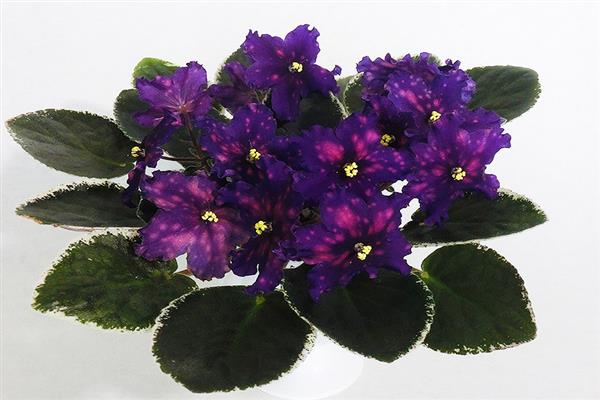
Violet South night: photo
It is possible to transplant an adult violet LE-South night less often than many other varieties. Instead of an annual transplant, it will be enough to carry out this procedure every 2 or 3 years. In the process of transplanting, try to remove most of the old soil from the roots as carefully as possible, you can also cut off some of the roots (only this should be done with a sharp and sterile instrument). And it is necessary to carry out a transplant before or after flowering.
During flowering, the Southern Night violet must be fertilized regularly using a special fertilizer for Saintpaulias. Top dressing is carried out every two weeks. During the dormant period, the plant does not need a large amount of nutrients, so it will be enough to feed it once every 5-6 weeks. Never fertilize plants with concentrate, be sure to dilute it in water for irrigation, strictly following the instructions.
Well, the most important part of caring for the Southern Night violet, which determines its well-being, is watering. The water should be pre-defended and, if necessary, slightly warmed up (to a state of room temperature)
To prevent moisture from getting on the leaves and flower stalks, violets should be watered through a tray. Within 30-40 minutes, the plant will absorb as much moisture as it needs, and the residues should be drained to prevent waterlogging of the soil.
Flower features
The size of the plant ranges from 0.5 m to 1 m. The bushes are of medium spreading, the branches rush upward along with the peduncles.
Colour
The color of the leaves and stems is grayish-green. Sometimes it has a slight bluish pubescence.
The color of the petals varies depending on the cultivar, but is always in the range from white to pale pink, from pink to purple, from pale blue to blue. There is also a crimson color.
Flowering time
Mattiola (Mattiol, night violet) is most often found in the garden. Distinguish between levkoy and two-horned. The flowers of the bicorn are very nondescript and small, but they are planted exclusively to obtain a gentle background and a pleasant smell in the evening.
For your information! The flowers of the two-horned mattiola close for a while, while the sun is shining, and after sunset they begin to open and emit an aroma.
But mattiola levkoy is planted for a decorative appearance. In the daytime, the buds of these flowers are open. Their diameter is quite large, they are bright and varied in color. Petals can be not only simple, but also double, which gives higher decorative properties. In terms of aroma, this variety is much inferior to the two-horned species.
Additional Information! In any case, flowering lasts about 2 months. Most varieties bloom from mid June to mid August. Some bloom and are replaced by other buds.
Habitat
Cultivation of matthiola is possible in Central Russia and southern regions, from the European part to Siberia. But these plants feel best in the foothills of the Caucasus and on flat areas.
The progenitor of decorative varieties of night violets is two-leaved lyubka. She is undersized and most often reaches 30-40 cm in height. Its peculiarity lies in the fact that it has 2 tubers that are not divided among themselves. Every year a new replacing tuber appears. Two leaves are formed at the base. At the end of the ejected arrow, a brush of pale colors is formed.
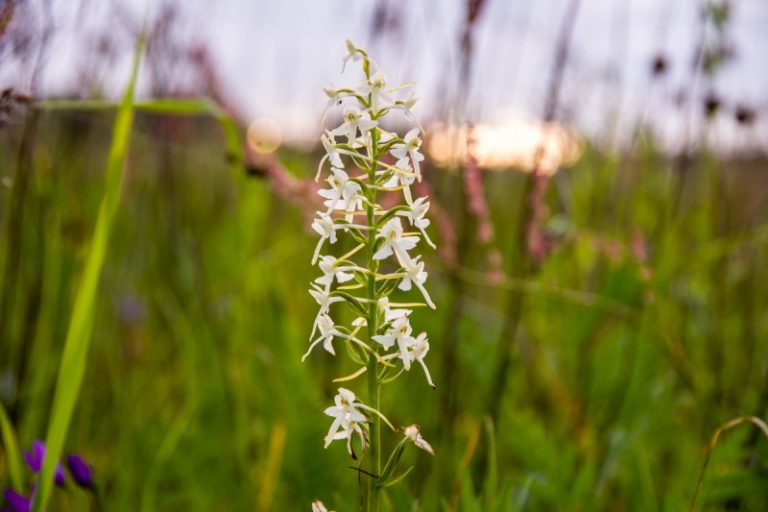
Lyubka is two-leaved
An interesting fact is that this plant is medicinal. For medicinal purposes, tubers are used, which contain glycosides and mucus, as well as starch and sugar. But it is the mucus, which is called salepa, that has a beneficial effect on the digestive tract, providing an analgesic effect. In addition, the plant is used for poisoning, abscess, inflammation of the bladder, nervous exhaustion, inflammation and non-healing wounds.
What does a night violet (mattiola) look like
The night violet has a scientific name - two-leaved lyubka and belongs to a group of biennial or perennial medicinal plants. It is also called hesperis, the matron's nocturnal, wild balsam, cuckoo tears, haystack, forest fracture. But many growers most often call it matthiola.

This flower has a lot of names.
For your information! Today, there are about 40 species, most of which are located in the European and Asian parts of Russia, as well as in the Caucasus. It is these regions that are the most favorable in terms of plant growth conditions.
A short description of what a night violet looks like:
- the plant belongs to the Cabbage family, belongs to the dicotyledonous class;
- when planted in open ground in the first year does not produce flowers. The plant itself reaches a height of 0.5 to 1 m;
- the stems are slightly fleecy;
- leaves are narrow, pointed at the base. Their length is about 12 cm, while their width is only 4 cm;
- flowers are small, 4-lobed. Large ones are observed only in artificially grown ones. The length of the inflorescences reaches 30 cm;
- their shade is usually light, but can range from white to pale lilac or pink.
- there are perennials that can bloom quite unusually compared to the standard night violet flower. There are also hybrids in which not simple flowers prevail, but double ones;
- a significant difference between the night violet is that it has a pronounced smell, which is felt not only in the immediate vicinity of the plant, but also fills the adjacent space. It manifests itself especially strongly in the evening after sunset. In this regard, this plant is unmatched among decorative flowering crops.

The plant will fill the entire backyard with its aroma.
Briefly about the history of appearance
This plant prefers to grow in mixed forests, bushes, forest edges or hills. Mainly grows as single specimens, that is, scattered, does not form crowded plantings.
The prevalence from Europe to Asia made the flower popular for growing in flower beds and balconies. This happened because of the wonderful aroma that fills the space. In addition, the appearance of the plant is so elegant, delicate and sophisticated that it is used by landscape designers to decorate areas that claim to be natural.
Note! To date, several hybrids have been bred, which differ somewhat in their external characteristics from the standard wild flower.
Common varieties
The night violet is a popular flower that comes in several varieties. Therefore, before planting it in a flower bed, you need to decide what effect you want to get. To do this, you can use the following flower subspecies:
- purple matrona has a bright pronounced aroma exuded by flowers of a fairly large size. They gather in cylindrical inflorescences. They are planted as seeds in open ground at the end of spring;
- hesperis Inspiration refers to 2-year-olds with simple flowers collected in a brush. The shades of the petals can be varied. The plant itself reaches a height of no more than 1 m. The aroma is lighter and more delicate;
- The romance has white flowers and a mild aroma, exuding only in the evening and at night;
- crimson nocturnal matron is the most common species. She has bright crimson flowers, chaotically growing on branched stems;
- Night beauty. Delicate lilac shades are collected in large inflorescences. But the shrub is less tall, only 60 cm maximum under favorable growing conditions. Gardeners often prefer this variety because it is hardy and easily resists a variety of diseases and parasites. Used for landing on personal plots and decorating balconies.
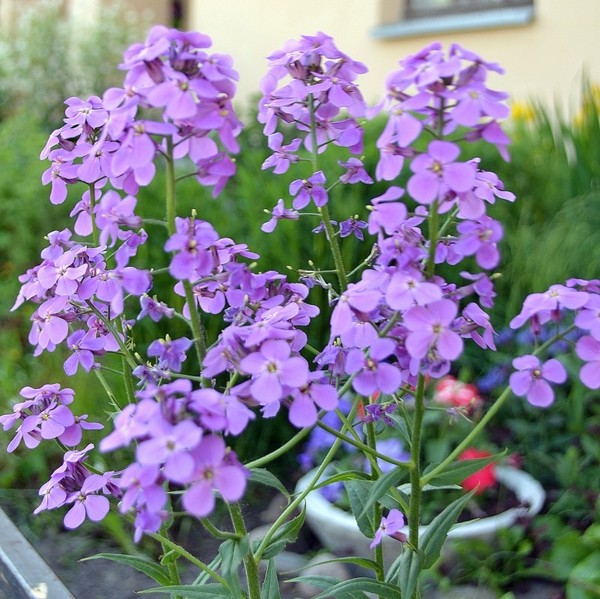
The variety Night Beauty easily tolerates winter frosts, does not require shelter
Violet RS-Princess Olga
Room violet RS-Princess Olga belongs to the genus of hybrid Saintpaulias, from the Gesneriev family. This variety has been bred in our time by the breeder S. Repkina, as evidenced by the RS prefix at the beginning of the name.
Violet RS-Princess Olga.
The rosette is large, even huge, in 9-ke it grows up to 45-50 cm. Sheets:
- Large;
- Slightly quilted;
- Dark green color.
You can see the photo of the violet RS-Princess Olga above.
There are few teeth along the edge of the leaf, and the shape is slightly heart-shaped, they have thick, medium-sized cuttings. The rosette forms itself and does not require a lot of light.
The flowers are large, simple stars, slightly wavy along the edge, the first up to 8 cm, and then they decrease slightly, but at least 6.5 cm.The color of the flowers is made up of two colors:
- Basic white;
- Complemented with bright fuchsia prints that sometimes take up most of the petal.
Flowering is temperature dependent and ranges from white petals with a stripe like chimeras to fuchsia with a white border.
Sports are rare for this variety, but sometimes kids with a pure fuchsia flower or a chimeric color come across.
Attention! Sometimes the chimeric flowering obtained as a result of care or failure is specially propagated by a peduncle to obtain a chimeric baby, but this does not always work.
Features of flowering, growth and reproduction
At home, the variety grows very well and does not require additional light, while the rosette is perfectly formed. An adult rosette can be grown in 11-12 months and blooms earlier, but the first bloom does not give full flower size.
This variety is propagated in any of the convenient ways:
- Sheets;
- Stepsons;
- Peduncles (especially for fixing a special flowering, for example, chimeric).
The variety is quite prolific, gives 2-4 babies from a leaf, and is often shared by stepchildren.
The variety blooms profusely - with a bouquet, large flowers cover the rosette almost completely, but their shape and size do not allow us to call this bloom a nodding bloom. Peduncles:
- Middle length;
- Strong;
- They carry 2-4 buds.
Flowering lasts a long time, and each flower lasts up to a week. The color varies greatly with temperature, the hotter, the darker the flowers - in a cool room it can bloom with a chimera, with a rather thin fuchsia strip, and in the heat the white part almost disappears, leaving a thin border around the edge.
Violet African Night (K. Katkin)
In terms of size, the African can be attributed to the standard, and some individuals even to the large varieties. Saintpaulia leaves:
- Large;
- Dark green with a reddish underside;
- They tend to disrupt horizontal growth;
- And they stretch to the top.
Flowers are large, deep dark purple in color, abundant lighting can lead to blue bloom.
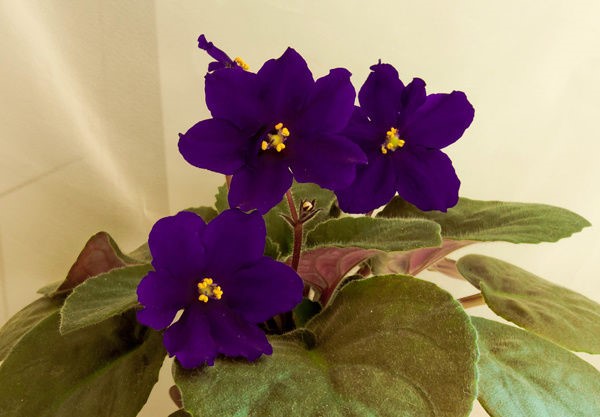
African night original.
This variety was bred in Odessa by the breeder K. Katkin. For a long time, it was considered the darkest variety, and this was the reason for its popularity. But the simplicity of the flower, and the dimensions of the outlet, after the appearance of darker options, pushed this beauty to the lower positions.
After breeding, sport blooming is quite common. The color usually remains maternal, only the underside of the petals is slightly lighter.
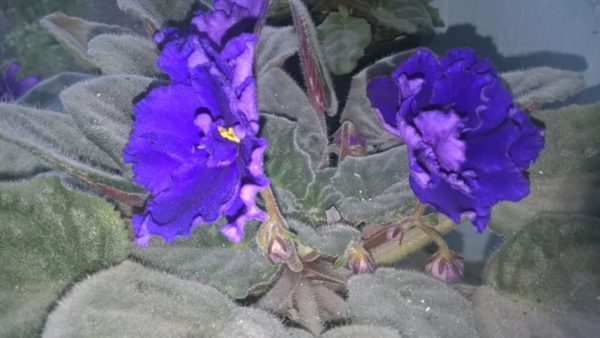
African sports night.
Attention! Most of such offspring have slightly double flowers, which, as before, have a huge size, but more of them are formed on the peduncle (in the standard 1-2, in the sport 3-4).
We will tell you about care and reproduction below.
Conclusion
In conclusion, some useful tips for lovers of violets from experienced florists:
- if you buy saintpaulia at an exhibition, be aware that the plant has been specially prepared for the show:
- fed in a certain way;
- the socket is aligned;
- the bottom leaves were removed.
therefore, after the plant settles in your house, it may change slightly - for example, the rosette will become larger in size, the flowers are smaller;
when buying a violet, pay attention to the stem. If it has a length of 1.5 cm or more, then the plant is not young and the lower leaves have already been removed from it
Choose young Saintpaulias for yourself;
purchased saintpaulia should not be put together with home flowers right away. It is necessary to withstand it in quarantine, having examined it for the presence of diseases.
It is impossible not to fall in love with Saintpaulia Summer Night. If you give her your warmth and care, she will repay with beautiful and long flowering.


